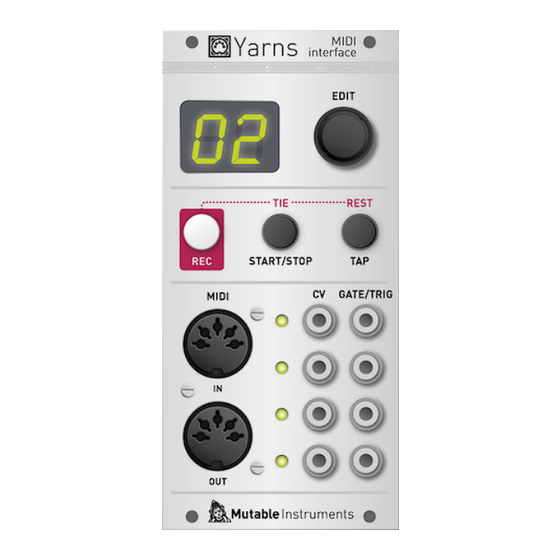
Advertisement
1/19/2018
Yarns
OVERVIEW
Yarns is a MIDI to CV interface. Thanks to its flexible architecture, it can manage up to 4 voices of polyphony
or up to 4 individual channels. Yarns embeds an arpeggiator, a note sequencer, and an euclidean pattern
generator.
INSTALLATION
Yarns is designed for Eurorack synthesizer systems and occupies 12 HP of space. It requires a -12V / +12V
supply (2x5 connector), consuming 2mA from the -12V rail and 60mA from the +12V rail. The red stripe of the
ribbon cable must be oriented on the same side as the "Red stripe" marking on the printed circuit board.
CONTROLS
At the right of Yarns' display is an encoder which is used to increment/decrement values and scroll through
options. The typical way of modifying Yarns' settings is to scroll through the list of settings, click the encoder
to select one of them, then rotate the encoder to increment/decrement the value of setting, and click again
once you are done. Yarns' display is small, so settings names are abbreviated into 2 letters code (VR =
"Vibrato range"). To ease navigation, the unabbreviated form of each setting or value scrolls on the display
after a few seconds of inactivity.
Below the display are 3 buttons, whose primary functions are to control the sequencer:
REC starts and ends step-by-step recording.
START/STOP starts and stops the sequencer.
https://mutable-instruments.net/modules/yarns/manual/
Mutable Instruments | Yarns
User manual
1/10
Advertisement
Table of Contents

Summary of Contents for Mutable Instruments Yarns
- Page 1 User manual OVERVIEW Yarns is a MIDI to CV interface. Thanks to its flexible architecture, it can manage up to 4 voices of polyphony or up to 4 individual channels. Yarns embeds an arpeggiator, a note sequencer, and an euclidean pattern generator.
- Page 2 Yarns can handle up to 4 parts, and there are enough CV/Gate outputs for 4 voices. This means that there are many different ways of getting these to work together! Each of these configurations are called Layouts.
- Page 3 1/19/2018 Mutable Instruments | Yarns In single-voice layouts (1M, and 2>), the 4 CV outputs are assigned to: V/Oct note Velocity Modulation wheel Assignable (aftertouch, expression pedal, breath controller, LFO… More on that in the “Layout and MIDI options”) The 4 gate/trigger outputs are assigned to:...
- Page 4 This section lists the different settings related to layout and MIDI reception. LA(YOUT): Voices/parts layout. The different options have been exposed in the “Yarns’ architecture” section. PA(RT): Active part. Many settings - such as the MIDI channel, arpeggiator pattern, etc. - can be set to different values for each part.
- Page 5 YARNS AS (AN) OSCILLATOR(S) Some of Yarns’ CV output channels can be reconfigured as digital oscillators. To do so, select the OS(CILLATOR) setting. The available waveforms are sawtooth, 25% rectangle, square, triangle and sine.
- Page 6 Yarns can use either its own internal clock, or an external MIDI clock source. The tempo is adjusted by modifying the TE(MPO) setting. Below 40 BPM, the display shows EX(TERNAL) - which means that the internal clock will not be used and that external MIDI clock messages are expected.
- Page 7 PLAYING WITH YARNS: LATCH AND KEYBOARD-FREE OPERATION Yarns’ arpeggiator starts immediately whenever a key is pressed on the keyboard. When all keys are released, the arpeggiator continues running for a few clock ticks (a length equivalent to an eighth note); and if no key has been pressed in this short period, it stops.
- Page 8 Mutable Instruments | Yarns Yarns also provides a way of triggering one-note arpeggios or hold notes without the need for an external keyboard. Hold the START/STOP button for a second. A note will be played and held. Its value is shown on the screen and can be adjusted using the encoder.
-
Page 9: Quick Setup
SysEx librarian utility and sent back later to restore these settings. *C(ALIBRATE)* displays the calibration menu (see next section). *E(XIT)* leaves the LOAD/SAVE menu. When Yarns is powered on, the first program (P1) is always loaded. It is recommended to regularly save your work there. QUICK SETUP Yarns offers a “quick setup”... -
Page 10: Firmware Update Procedure
Mutable Instruments | Yarns FIRMWARE UPDATE PROCEDURE Power on your modular system with Yarns’ encoder pressed. The first character of the display will show a “snake” pattern. Yarns is now waiting for a SysEx data transfer on its MIDI input port.
Need help?
Do you have a question about the Yarns and is the answer not in the manual?
Questions and answers